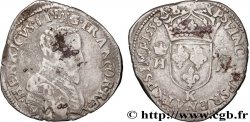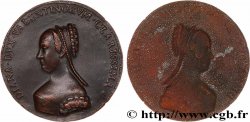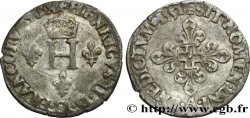fme_926195 - HENRY II Médaille d’Henri II et Catherine de Médicis, refrappe
70.00 €(Approx. 79.80$ | 60.20£)
Quantity
Add to your cart

Type : Médaille d’Henri II et Catherine de Médicis, refrappe
Date: (1555)/1987
Mint name / Town : Monnaie de Paris
Metal : bronze
Diameter : 61 mm
Orientation dies : 12 h.
Weight : 108,88 g.
Edge : lisse + 1987 + corne BRONZE
Puncheon : corne BRONZE
Coments on the condition:
Patine hétérogène avec quelques petites rayures
Obverse
Obverse legend : HENRICVS II D. G. FRANCORVM. ET NAV. REX.
Obverse description : Buste lauré et cuirassé de Henri IV à droite.
Reverse
Reverse legend : KATHARINA DE MEDICIS REGINA FRANCORVM 1555.
Reverse description : Buste à gauche de Catherine de Médicis.
Commentary
Médaille conservée dans une boîte rouge de la Monnaie de Paris
Médaille frappée depuis 1880, avec le poinçon corne d’abondance.
Henri II, né le 31 mars 1519 à Saint-Germain-en-Laye et mort le 10 juillet 1559 à Paris, est roi de France de 1547 à sa mort. Deuxième fils de François Ier et de Claude de France, il devient l'héritier du trône à la mort de son frère aîné en 1536. Il reçoit alors les titres de dauphin et de duc de Bretagne.
Il épouse le 28 octobre 1533 Catherine de Médicis, fille de Laurent II de Médicis, unique héritière de ses biens et nièce de Léon X, mais son cœur reste voué à sa confidente et préceptrice depuis l'âge de 15 ans Diane de Poitiers (avec qui il semble n'entretenir un adultère qu'après 1538 seulement)..
Médaille frappée depuis 1880, avec le poinçon corne d’abondance.
Henri II, né le 31 mars 1519 à Saint-Germain-en-Laye et mort le 10 juillet 1559 à Paris, est roi de France de 1547 à sa mort. Deuxième fils de François Ier et de Claude de France, il devient l'héritier du trône à la mort de son frère aîné en 1536. Il reçoit alors les titres de dauphin et de duc de Bretagne.
Il épouse le 28 octobre 1533 Catherine de Médicis, fille de Laurent II de Médicis, unique héritière de ses biens et nièce de Léon X, mais son cœur reste voué à sa confidente et préceptrice depuis l'âge de 15 ans Diane de Poitiers (avec qui il semble n'entretenir un adultère qu'après 1538 seulement)..








 Report a mistake
Report a mistake Print the page
Print the page Share my selection
Share my selection Ask a question
Ask a question Consign / sell
Consign / sell
 Full data
Full data









